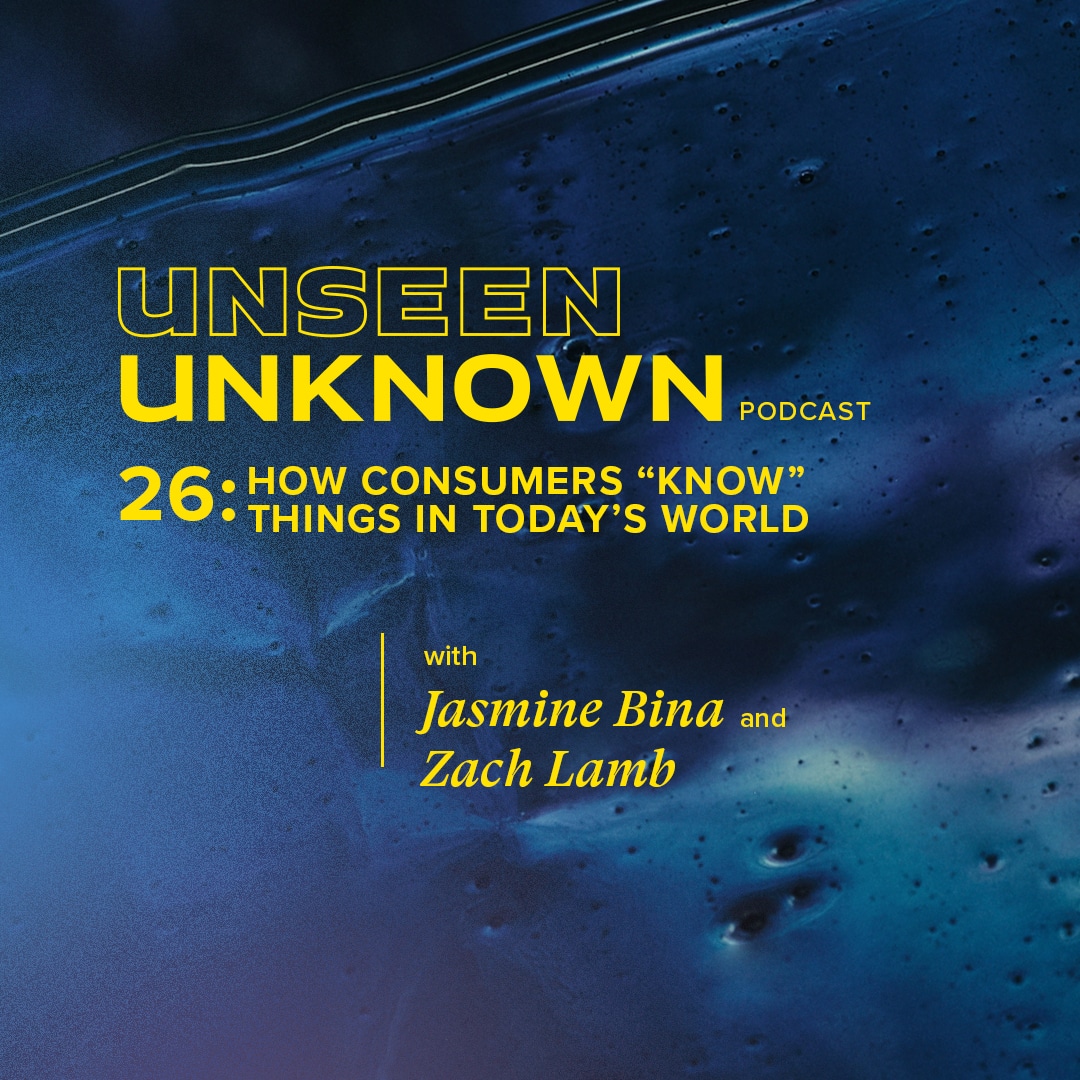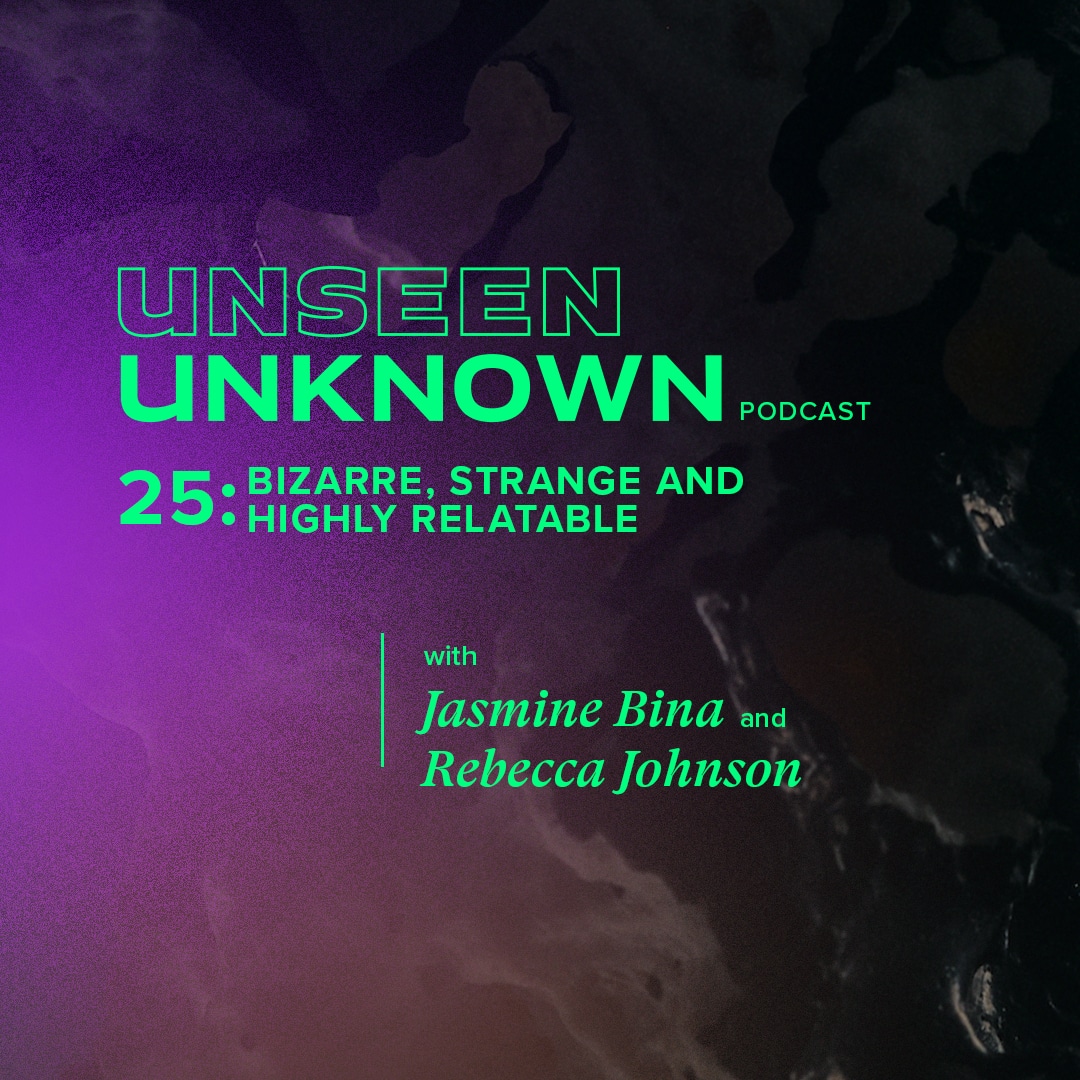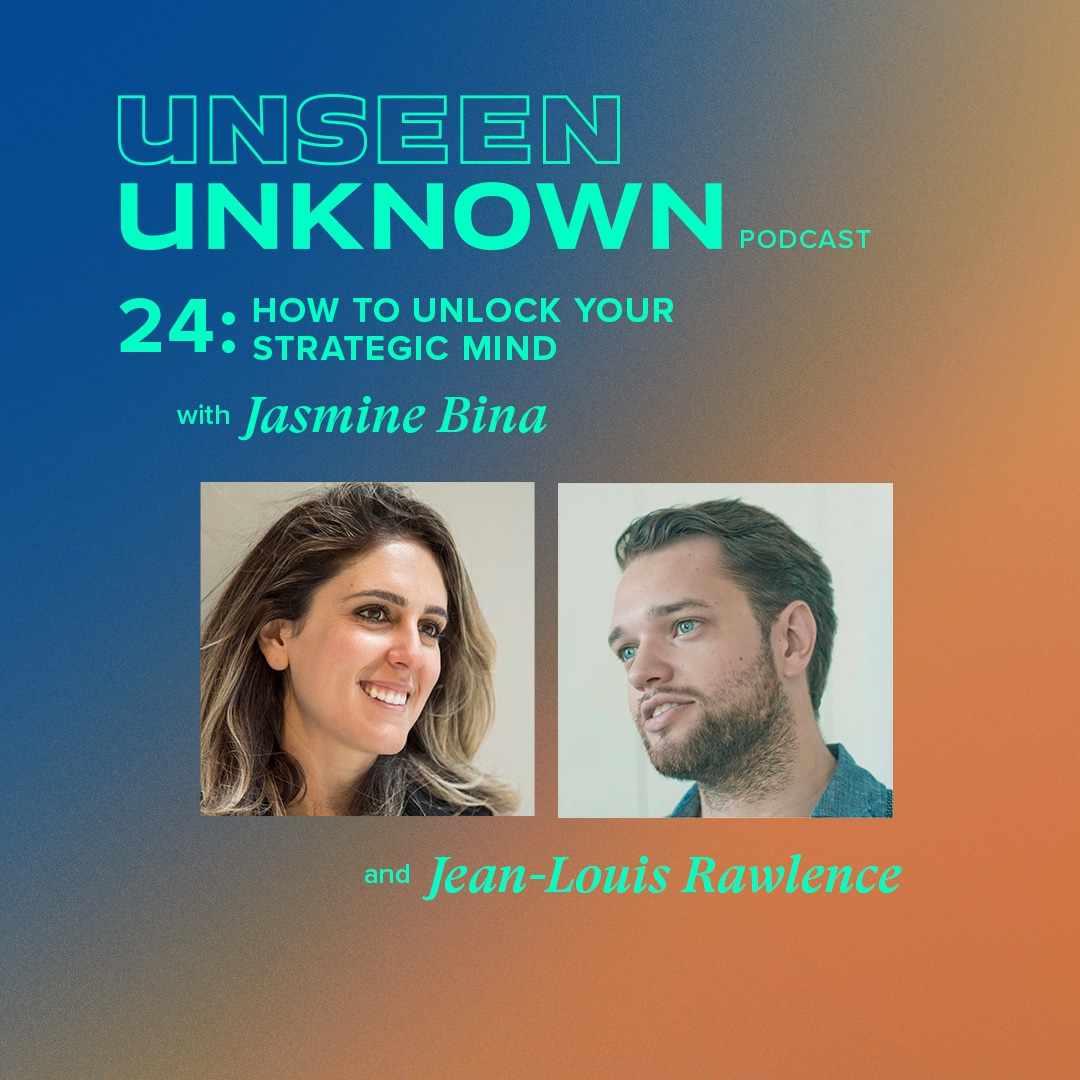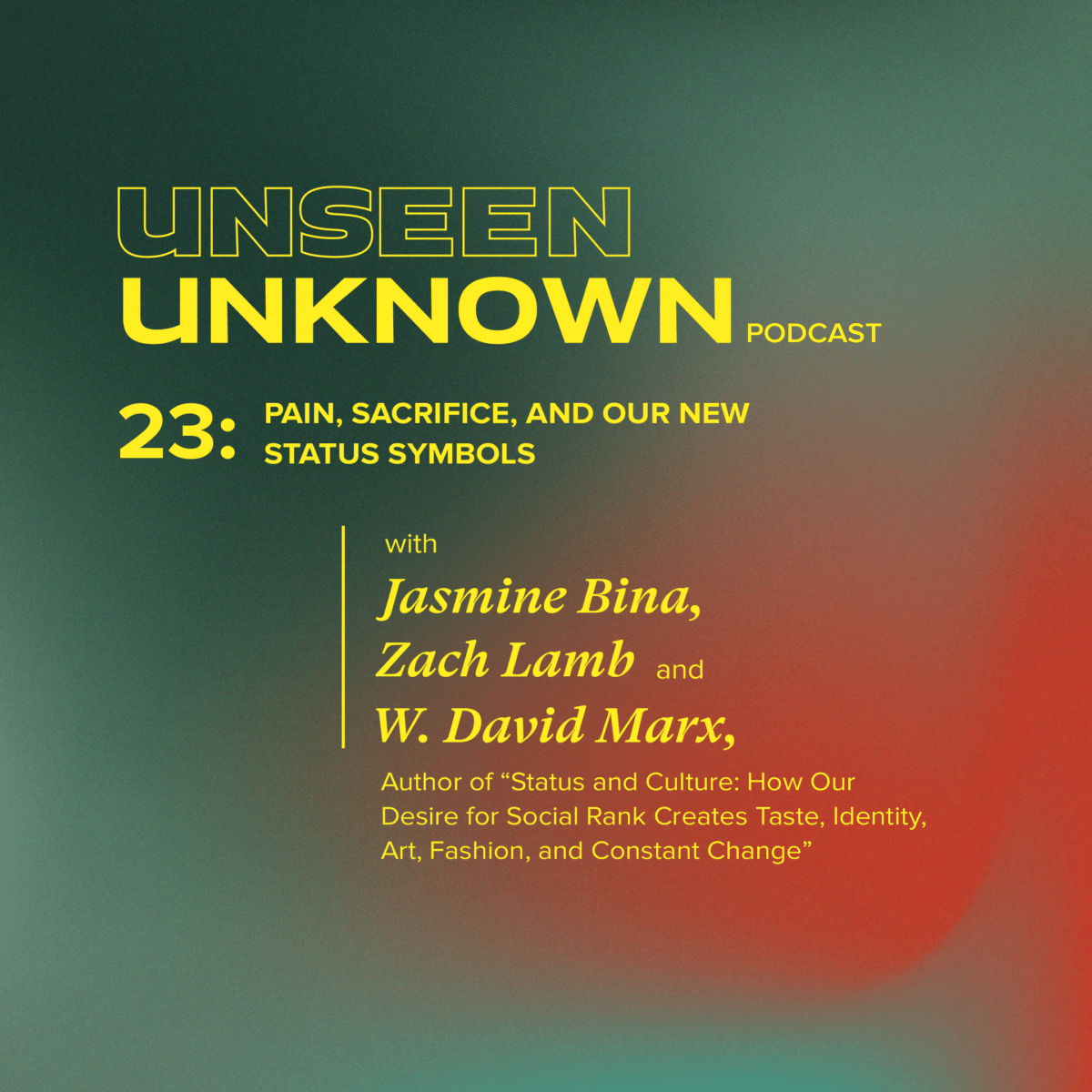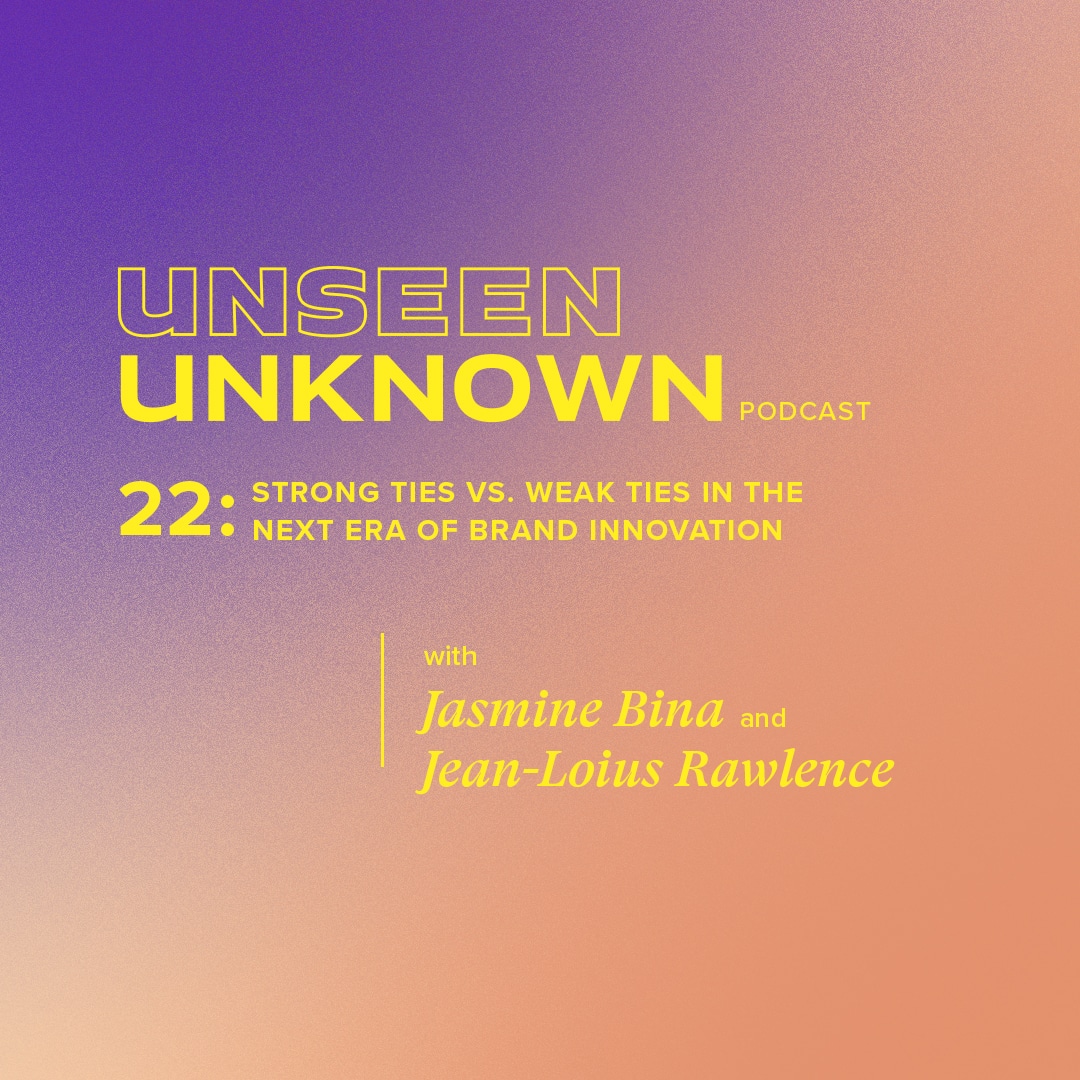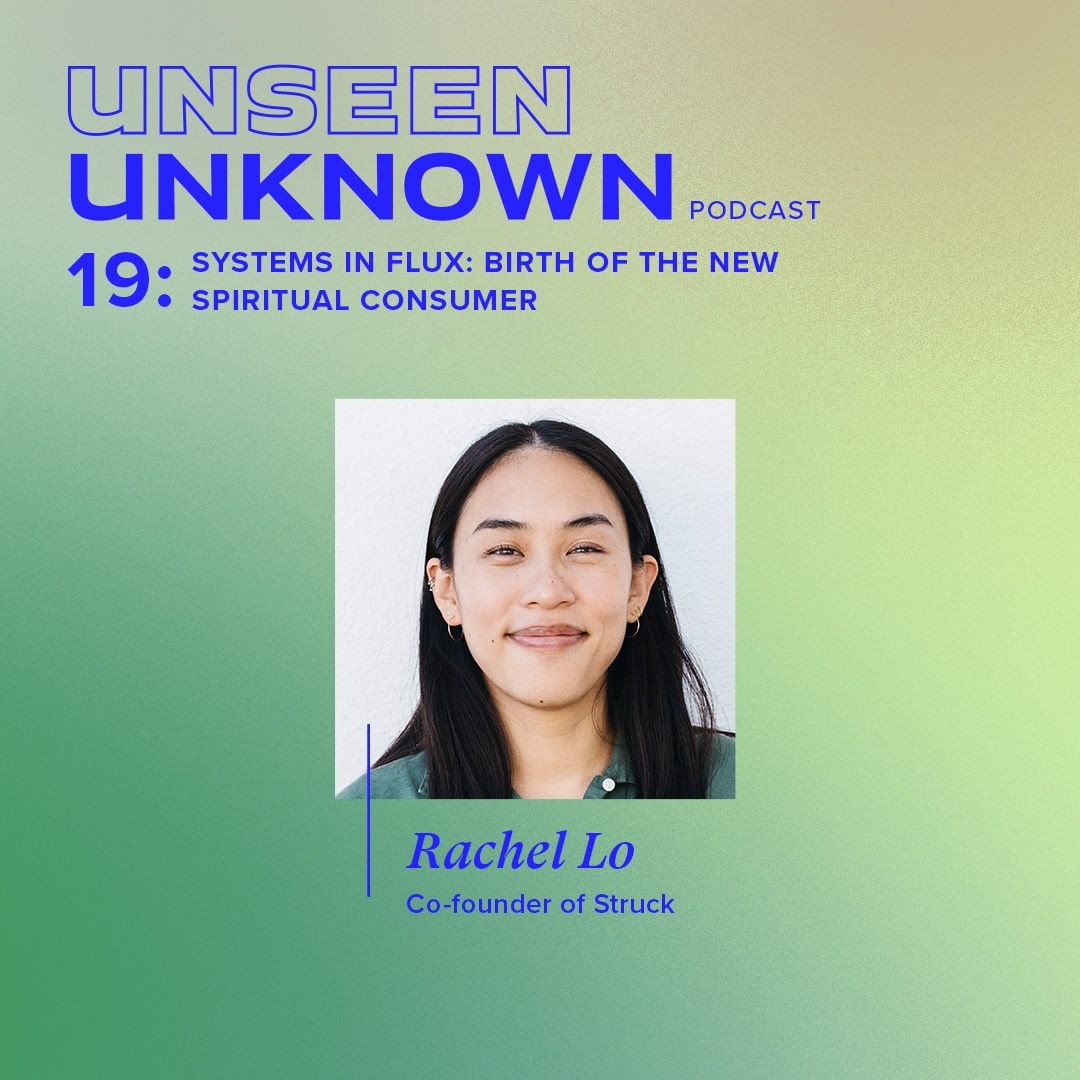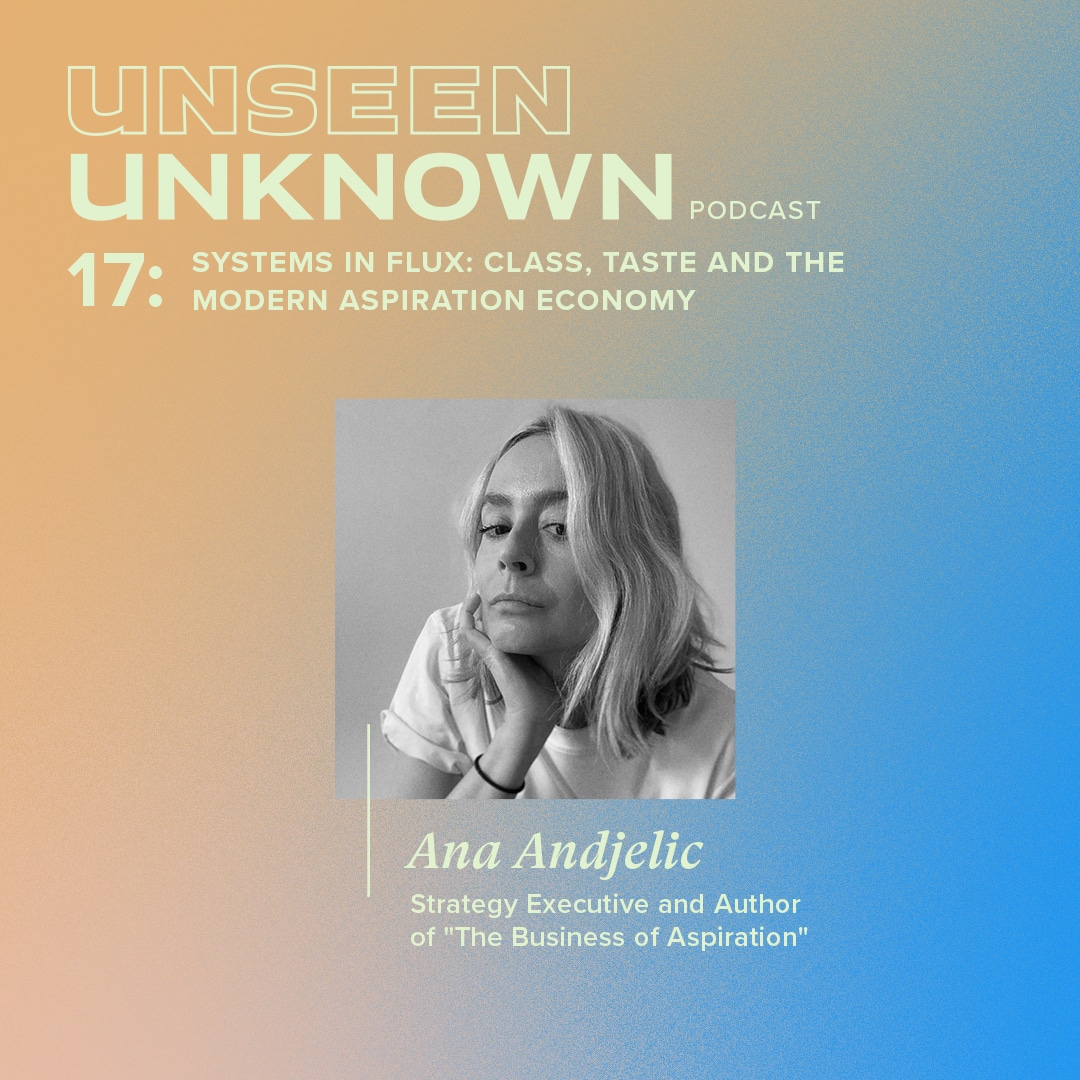From the way we create our identities and manage our health, to the way we employ therapy-speak at work and vote in elections, it’s apparent that people are increasingly being guided by feelings and intuition in places where they may have once relied on reasoning or ideology.
This noetic, direct-knowing way of moving through the world may sound familiar to you. Perhaps a colleague was “guided” to change careers, or a friend decided to “detox” their personal life. Maybe you, yourself, have dabbled in any form of “energy” practices.
None of these major decisions came from religious ideology. None of them came from scientific reasoning. They came from a third place of intuition, and this is an important cultural shift that revalues knowledge in our world.
When 87% of Americans believe in at least one New Age spiritual belief, it’s clear this third place of knowing is growing. But what is really interesting is what we see when we drill down into that majority.
What we find is not so much spirituality but instead the very definition of noetics: knowledge that is felt to be true, inside, by the self, with intuition as its defining experiential characteristic.
In this house episode, Concept Bureau Senior Strategist Zach Lamb gives us a clear, compelling look at what this third epistemology actually is and how we’ve seen this new belief system emerging for the past few years in our work at Concept Bureau.
It is a domain that is both needed and felt, but not yet surfaced in our culture… and that is the formula of a golden opportunity.
Podcast Transcript
NOVEMBER 20, 2023
24 min read
HOW CONSUMERS “KNOW” THINGS IN TODAY’S WORLD
00:12
Casie:
I think the older I get, the more I realize I just want to be spending time in a way that fills me up. So I’m obsessed with utilizing my time in ways that I feel are fruitful, that make me feel alive. As weird as that sounds, that’s what I’m trying to explore, I think, on a continual basis so that I can feel like I’m not just a robot doing my job and going to the grocery store and doing laundry like we all have to do, like how do I wake up?
00:47
Jasmine:
Welcome to Unseen Unknown. I’m Jasmine Bina. The woman you just heard speaking is Casie Cook. She lives in Minneapolis and she’s a highly creative person in a creative field with a great successful career. She also has a podcast and she’s just written a book, and you might’ve heard something very familiar in what she just said. Casie wants to always be waking up. She wants to feel alive and not succumb to the robotic routines of the ordinary life and daily work. You might feel this way too. It seems like most people have been talking and feeling like this for a while, but what’s interesting is that my conversation with Casie is about how she chooses the things that she consumes in her life, from experiences and people, right down to her purchases. How do people like Casie, who represent a growing mindset of people in the world right now choose the things that they will buy, whether it’s goods or experiences, products or services? How does Casie make her decision?
01:50
Casie:
Everything that speaks to you is just holding up a mirror. And in my mind, the world is like whatever is in your line of sight and in your consciousness is just somehow mirroring back to you something in yourself. I feel like, how else would you make decisions? As a person, I’m super OCD. I am always in my brain, and I remember 10 years ago my therapist was like, “You need to live less in your brain and more in your body.” And I was like, “In my body, how do I live in my body? What does that mean? Because I think my thoughts in my head,” and I was thinking, she’s like telling me I should work out more or something, and then I realized that, “Oh no, she’s telling me to feel first and not think first.” And so that, I mean it was 10 years ago, changed how I approach everything, every decision I make, from whether I’m going to go to this coffee shop or that coffee shop. Even the other day, I’m staying at a hotel right now.
02:55
There’s two coffee shops right next to each other. They’re literally on the street next to each other and I can just feel my body almost just going right before going left because that’s what I was drawn to. It’s a pull to, “Oh well, this is the obvious choice for you, Casey, because you know yourself.” And the more deeply that you know yourself, the easier I think those things are. It’s all a feeling toward, and that only came from getting out of my head and overthinking everything over the last 10 years since my therapist first said that. You can’t rationalize the world. The world is chaos. We’re just moving through an insane expanding universe. If you know yourself well enough, you can feel through anything.
03:42
Jasmine:
Casie feels her way through life. It’s not about expert reviews or what her friend said or what’s cool or ticks off the boxes, or what’s best or proven or special. It’s something else. In this house episode of Unseen Unknown, we’re talking to our Concept Bureau Senior Strategist, Zach Lamb, about this new way of knowing the world. Zach calls it noetics. It’s something that he’s been studying and recently wrote about in his article, The Noetic Future of Culture and Brands. Noetic Knowledge prioritizes intuitive knowing. It’s not science, it’s not religion, and it doesn’t replace those things either. It’s this third new thing, it’s inner wisdom, a subjective experience that you feel to be true within yourself. And when you hear Casie talk, it’s clear that it’s what she feels too. It’s her compass for navigating the world even down to how she acts as a consumer. Because in a world that as Casie describes it is chaotic, it seems that our old ways of understanding what is right and true and worth having aren’t enough anymore.
04:55
Zach:
Noetics, it’s an epistemology. Epistemology just simply means the study of how we know what we know, not focused on the what, just what are the rules that govern how it is we can know anything. What qualifies this knowledge and what doesn’t. So as an epistemology, noetics refers to the kind of knowledge that we derive internally. It’s our inner wisdom, our inner knowing, knowledge in the body, things like that. It goes by many names in culture, vibes, intuition, gut feelings because it’s a murky concept, but we all have it. Everybody has noetics inside of them. It’s knowledge that we just feel is true. We can’t really explain where these feelings come from or how we have them, but everybody’s familiar with, “Oh, I just know that I know.”
05:36
Noetics as a form of knowledge, then what’s different about it from say, scientific knowledge or in the older times of religious knowledge, it’s entirely subjective. It’s really, really hard to share and convey how it is you know what you know. You just know that you do. So there’s a share ability problem, but it feels so true to the person experiencing this inner form of knowing and it has implications for expertise in who we look up to and trust in society because we used to trust God or scientific knowledge, and now we’re increasingly trusting ourselves in this inner form of knowing.
06:13
Jasmine:
So when you say noetic knowledge or inner knowing, vibes, what would you say to somebody who said, “Isn’t that just intuition? Hasn’t that always been around?”
06:21
Zach:
I think I would respond to that person to that question with, what is intuition? Nobody can really answer that. Everybody talks about intuition, but nobody knows what it is. The best definition that I could give you, which again just is mine, is that it’s feelings that have some sort of significance attached to them. Then you have to ask, what is that significance? Where does that come from? And then you’re quickly opening up a whole can of worms that leads to spirituality, perhaps. I don’t even really know what intuition is, but yet it’s something that we all have.
06:52
So what I was trying to get at with summarizing this research that I did was that there’s a lot of signals in culture, a lot of things that are starting to point to, more and more people are trusting their intuition saying, “Hey, I’m going to tap into this. This is a thing, or my noetic knowledge, and I’m going to start structure my life and live according to these feelings that I have about myself and about the world in a much bigger way than ever before,” so that it’s rising to this level of science and religion as an epistemology that structures how people want to live and the things that they do and ultimately buy. Yes, it’s intuition sort of, but it’s all these other things. And the argument that I’m making is that it’s getting much more important and much louder in culture. More of us are acting on it.
07:38
Jasmine:
So we have scientific knowledge, we have religious knowledge. Somewhere among these two things, we have this third epistemology, which is the noetic knowledge coming through. Why now? Why do we see this coming through in culture now? The way it sounds, it could have emerged at any other time. Why are we seeing it now? And I do see it the way you describe it, I see it. I’m sure people listening see it as well. I mean, is there something special about this current time in our culture that has made noetic knowledge able to come through the surface?
08:04
Zach:
Epistemologies first and foremost, there’s stories. They’re mythologies about the world and how the world is structured and how you’re supposed to live and what you’re supposed to do, what constitutes the basic fabric of everyday life. And so if you look at epistemologies as stories, they tell different stories. So the story of science historically has been that humans are above nature. It’s our duty to control, use nature for our benefit. We’re separate from it. We’re not animals. We’re this thing that’s above. We are the smartest thing on the planet and we have to steward all this stuff. We have to control it and ideally use it for our own benefit, and that’s what we’ve been doing for the last 500 years, and it is led us to this place where we now have this environmental crisis and we’re trying to figure out what we should do about this globally destructive version of capitalism that we’ve been on.
08:51
So in some sense, you can look at that story as needing to be replaced, needing to be updated, needing to be refreshed. Likewise, religion, the story of religion is not that humans are at the top, we’re at the bottom. God’s at the top and this is the way of the world and follow these rules. Everything is usually written down here and just live this way. Both the stories of science and the stories of religion in this sense are depersonalizing. There’s not a space for me and how I think and feel in either of these scenarios. And so noetics is really, really ripe for this time where we’re turning inwards, we’re turning into ourselves for, “I’ve got to trust me because I can’t trust society around me.” There’s countless examples. It’s in the news all the time of all the things like at the level of the social that are causing us to trust ourselves more and each other less, and it’s certainly institutions and experts and science less.
09:43
Obviously, we’re now increasingly living in post-truth times and who knows what AI is going to do to that. So are we going to trust in that? I’m going to trust in me. And if you think about it in the personal level, as I mentioned at the start, we have this existential need for order and control of our lives, “Just give me a meaning system that helps me make sense of the world and knows my place and helps me feel good.” We used to get that level of meaning from work, family, our class position, gender. There was so many rules and so many boxes. You’ve written about this and talked about this breaking down with high fidelity society, so that induced a meaning crisis. And John Vervaeke’s got a great YouTube series on the Meaning Crisis where we have to try to make meaning for ourselves now. It’s like it’s up to me to become something in a way that I can’t just take for granted and assume an identity.
10:31
So who am I going to be? What am I going to do? So there’s a lot of internal focused questions that are coming into the picture increasingly more and more. Last thing I would say is there’s some problems with the current narrative stories on the level of the spiritual, because if you go back to 10,000 years and before the epistemology then was just nature. We were just in this subservient position to nature. Imagine if you’d see a tornado, what would you think? Imagine if you saw a total solar eclipse, you wouldn’t really know how to think or act. You would just be in awe of these forces around you. So life was filled with a lot more wonder and enchantment and mystery. What’s great about science is that we’ve led to this massive technological progress, but the flip side of that is that it has stripped away a lot of this awe and wonder and mystery in daily life.
11:21
Sure, there’s still a lot of big questions that we don’t know that’s exciting, but just the fact of daily existence, there isn’t this enchantment that there used to be. Also in this research I was seeing a lot of what’s going on with all of the resurgent, new age spiritual stuff. Why is belief in reincarnation coming back? Why are tarot cards sales up? Why is hashtag witch such a huge hashtag on TikTok in the billions? There’s obviously a hunger for mystery and enchantment and wonder in this narrative society that science and religion had built. The narratives of science and those stories, it’s leaving out that wonder. And so noetics comes in and says, “Well, maybe there’s multiple intelligences. All things are interconnected and we feel that there’s a planetary intelligence at work here.” These kind of stories they’re really ripe for right now. I listen to a ton of science podcasts myself.
12:19
You’re always hearing scientists with a new book coming out about awe sciences or, I was just listening to one this morning about Interconnected is the name of his book, and there’s another one that was Planetary Intelligence. So it’s really creeping into the scientific zeitgeist too, even though I’ve been vilifying science so far, this notion of interconnection. So basically, long story short, the old narratives are dying and we need to replace them with new ones, and that’s going to come from this internal place of inner knowledge. It’s really this journey inward that’s going to create new narratives and new stories.
12:52
Jasmine:
And just to go back to something you said at the beginning of this, when you were talking about how 500 years ago, if you go back and look at American governance and history, when we were starting to really develop the land, the kind of language that you see in paperwork of the time or edicts or whatever, laws about how it’s our God-given decree, it’s our responsibility to shape the land, to create dams, to move mountains, to build things. People actually believed it and it’s such a stark contrast to where people are today, and it’s crazy that, that’s just been a few hundred years and we speak so differently about the land around us, but it’s hard to imagine that that felt so right and so true and so pure.
13:38
Zach:
I think that raises a really interesting point because I don’t want people to think that these epistemologies replace each other. Just a new one gets added, and when you’re talking about our God-given right to steward the land that was coming from God and then we get science to help us do that, things get added. And noetics is something that’s ancient. We’ve had this inner wisdom and inner knowing as long as we’ve been humans. Right now we’re actually remembering it.
14:04
Jasmine:
Yeah. It does feel like a returning to something the way you describe it. So give me some examples. What’s a signal of noetic belief that I might see in my own social circle or in the market or in certain categories? What would I point at and be like, “Yep, that’s noetic knowledge?”
14:19
Zach:
You’re seeing noetic knowledge when people talk in a way, or about things that can’t be proved objectively but are nonetheless deeply felt, deeply held and then acted upon. You see a lot in the personal lived experience, discourse online and trauma discourse, there’s this sense of the body keeps the score that famous book about trauma, it’s in the body. I feel that my truth isn’t being heard. I feel that society is structured in such a way that I’m not able to thrive, I’ve kept out. When people talk about coming home to themselves, finding their authentic selves, any sort of interrelationship about self in relation to society, that’s really noetic because where is that coming from? That’s coming from an internal understanding of a feeling and who they are and what they are in the world. So that’s a really loud one that really rings true of that inner knowing.
15:10
You also see it a ton in all of the psychedelics discourse today. Psychedelics, perfect noetic technology. You can’t get something better. You can’t go farther inward than that generally. So it’s just shining the spotlight on that noetic sensibility. Clearly culturally, we’re craving that. The old narratives of the scientific era was that, we were going to advance by going outward to the stars. We’re going to colonize Mars, we’re going to colonize the galaxy. It’s looking like actually the stars are in. We’re going to go increasingly inward to go forward, and I already alluded to just the growing spiritualization in all of its forms, from the deepest realist or to just the stuff that can seem trivial and light.
15:52
Just taking it all together says, “This is a loud signal of seeking for something,” and I was interpreting that from the research is what we’re seeking there is that mysticism, that wonder, that connection to that sense that something is gone, so I also think that that is coming from within. You also see lastly, so much discourse about, “Can we just live differently? I want to live in a commune with my friends or I want my chosen family. I feel that you’re my family.” Just new forms of community that are updated for how we feel now, and we didn’t get to really choose all this stuff before.
16:26
Jasmine:
And this is daily life, when we zoom out and look at this in industries among brands, what are you seeing there?
16:35
Zach:
Post-truth categories is what I’ll call them, anywhere where trust has taken a hit and accompanied by the felt sense of, “This could be way better. This isn’t serving me,” so the obvious ones. Noetics can be an opportunity for brands and categories that are traditionally playing in science, health, medicine, wellness, therapy, education, really all the basic modern institutions. You’re starting to see a lot of startups that answer, “This could be better. We know you feel this way,” and that’s what’s really interesting about noetic brands is they don’t offer you a story about become something else. Emotional benefits have always been, “If you buy our product or use our service, you’ll feel this way about yourself,” whereas it’s shifting. Brand benefits for noetic brands are like, “Yep, you are validated. You should feel this way. You’re right to feel this way. Your sensibility was right.”
17:27
So brands are stepping in to validate those feelings in a really interesting way. It’s a much deeper narrative than values-based branding. We’re all very familiar with what that sounds like. You take a stand, it’s usually implicitly an enemy that you’re against. That’s how brands have positioned a lot in the last decade or so, but I think noetics is an invitation to deeper narratives that touch a lot of this more existential stuff that we’ve been talking about. Even Febreze I think I uncovered in the research, Febreze was starting to engage customers on existential terrain. So it is just an opportunity to deepen the conversation beyond values. I think I saw something too in this research that Unilever was going to be giving a values-based mission statement to all 400 of its brands. It’s like just show us how saturated values-based branding is, and there’s an opportunity for this more soulful, feelings based, either you get it or you don’t kind of brand opportunity.
18:32
Jasmine:
All right. So if I’m a brand that’s leaning into noetics and it makes sense for me, what is that really going to do for my users? I’m guessing it creates more of a stronger emotional bond. You talk about validation, but tell me more about what this does for the relationship that the user has with the brand.
18:46
Zach:
Yeah. It cements that bond because it says that you’re on my tribe and you see the world and you share my… I don’t want to use values, but you share my noetic feelings about the world. I have these preexisting truths and intuitions and hunches that I’m carrying in, and what I’m looking for from brands again, is not to be transformed, but to be reaffirmed. So in that sense, they’re offering us a world to live in that feels comfortable and feels safe. So for instance, Tia Health is one of the health brands that I’ve mentioned that’s branching out from just a classic expertise model. If you’re pulling your kid out of school and putting them in homeschool, you’re getting your internal feelings validated more than you’re getting education, and if you’re buying a gun, you’re getting validation and identity reinforcement, not necessarily safety.
19:34
So all roads lead to this sense of validation. I think maybe you’ve noticed consumers tend to be experts on a lot of things these days. I don’t pity a brand that’s trying to be an expert right now because it’s so complicated being an expert when you’re trying to say that, “I know more than consumers,” and so it’s the business of validation and being for some and not for all, just giving them these signs that you’re living a good life.
20:00
Jasmine:
I do want to add a little more context to what you said about Tia Health. So Tia Health does offer incredible healthcare, but I think what you’re saying is that really what sells for them, what is attracting their users is the fact that they’re leading with this story of validation, understanding, seeing people that feel they haven’t been seen before, which really spoke to me as a woman. I think these were all easy examples. I’m assuming you should be able to apply this noetic framework to any category, so let’s take another category. Let’s try something like travel for example. If you had to say how all these epistemologies work together in travel, how would I see that in that space?
20:41
Zach:
Yeah. Let’s say I’m taking a religiously motivated vacation. We won’t call it religious but sacred. You’re going to visit the Cannon, you’re going to visit the wonders of the world. You’re going to visit the Louvre, you’re going to go to sites that have ancient significance, these things that are given a religious cast, anywhere from actual holy sites to just modern holy sites like the Louvre. This feels like I’m paying homage. I’m acting as a pilgrim. I’m seeing the things in the book that I’m supposed to see, whereas if I’m going to take a scientific vacation, I just saw something last week about high end travel to Antarctica. That’s a very huge expedition that feels very scientific. Or maybe we want to retrace Darwin steps and go to the Galapagos Islands or take an African safari. These things feel very, the classic mode of being of science, “Let me get out there and discover.”
21:31
And earlier a bout of research I did on direct to consumer anti-capitalism, I found Viking Cruises was offering people the opportunity to go collect ocean water and then get back on the cruise ship and analyze it for acidification in the waters. While you’re on a $10,000 cruise, you’re acting as a scientist, so these things like that. No wedding vacations, it’s like, “Oh man, I like the vibe. I really wanted to go because I thought it felt good,” or I’m trying to have a peak ayahuasca experience in Peru, not just in my city. I need to take this very sacred to me, that’s the difference, sacred to me.
22:10
Because I just described the religious Cannon, but noetics just feels sacred only to me, or maybe I want to go to Burning Man and ideally not get stuck there and get out, or go to Stonehenge things that feel sacred and personally significant to me. You can see how this gets really, really complicated in this era of noetics because it is so subjective and it’s that thing to me, and it’s just a natural extension of reality tunnels and tribalism and post-truth, and so many different epistemologies. It’s like, of course, we’re going to have this noetic rise when we live in that world.
22:41
Jasmine:
What would you say to people who, like me, when I first heard your theory on all of this, who bristle at all of this? Because there is something that I would imagine it’s going to make a lot of people feel uncomfortable. It’s almost like a step back into the dark ages, especially after we saw what happened with COVID and people were using their personal truths, their own direct knowing, their own beliefs and intuition to exert their choices over others. What’s your response to that?
23:13
Zach:
I don’t think we can roll it back. I think yes, noetics is a further evolution into this journey that we’ve been on as a society for 20 years, and there’s no stopping it. I hope that we can see the positivity here. Yes, there are a lot of affirming feelings. All of, for instance, the stuff that’s been happening, you just mentioned Tia Health, and all of the stuff that’s been happening with lived experience and your personal truth and all of the understanding that’s come from that. It’s like with any new advancement, we’re on this increasingly complex journey that’s going to always be good and bad, and it’s just the new world we have, and personally, I just hope that we can somehow figure out how to live in this multiverse together of different realities versus needing to make all of the other realities subscribe to my reality. If we can just get that honeycomb piece, then we’ll be good, but that’s my hope.
24:07
Jasmine:
Okay. So now I feel like the other big elephant in the room is AI. AI to me feels very opposed to everything that you’re discussing in Noetics. It’s almost like they’re in reaction to each other in some way. What do you see happening in the tension between this noetic felt personally known, intuitive truth versus AI, which is almost like an absolute truth?
24:31
Zach:
All of the stuff that I’ve been talking about, all of the old stories and all of the critiques of scientific society and those narratives, and also the desire for more wonder and enchantment and awe, that was all happening before AI. So AI comes onto the scene and suddenly we have to ask questions of, what is a human? What is human knowledge that AI doesn’t have? What’s unique and special about me? Talk about that scientific narrative of human beings at the top, how do we even live in a world where human beings are not the smartest thing on the planet, and maybe there’s so many different forms of intelligence now and a lot of them are smarter than us, so what are we going to do? What does that even mean for our future? The questions that it has caused to arise are as big and deep as they get, and so what are you going to lean on to answer those questions?
25:16
The hunch that I have is that noetics and inner knowing is just going to get more important, more special to us because it’s going to be likely the thing that we feel that we have that defines our sense of intelligence. And as I mentioned, it’s such an interesting time to be alive because you don’t have these moments often where you’re living through a period of profound bedrock level narrative reinvention, and I think we’re going to get through it. I think it’s going to be rocky for 10, 20 years, but I think that we will get through it and it’ll be interesting, and I think noetic acknowledge it’s really going to be, like I said, the thing that we think is us, that’s what my intuition tells me. So I think it’s just going to get louder and more important in society.
26:10
Jasmine:
That’s it for today, friends. Thank you so much for listening to this episode of Unseen Unknown. If you feel that this podcast has added any value to your work or life, please leave us a rating and a review. Those ratings and reviews mean a lot and they help our audience grow. And don’t forget, you can always get more of our brand strategy and culture articles, videos and podcasts at conceptbureau.com. While you’re there, you can also sign up for our awesome newsletter that will deliver valuable thinking to your inbox a few times a month, and I promise you will love it more than any of your other newsletters. It’s a big promise, but it’s true. Thanks for listening. We’ll see you next time.

